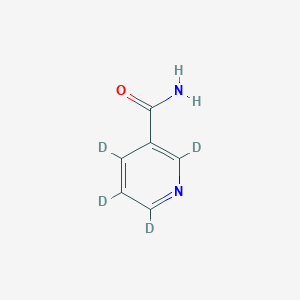
Nicotinamide-d4
Vue d'ensemble
Description
Mécanisme D'action
- Nicotinamide-d4 (also known as niacinamide-d4) is an amide form of niacin (vitamin B3). It can be biosynthesized in vivo or obtained through the diet .
- Additionally, this compound inhibits sirtuin 1 (SIRT1) with an IC50 of less than 50 µM . SIRT1 is involved in various cellular processes, including gene regulation, stress response, and longevity.
- This compound increases the activity of serine palmitoyltransferase (SPT) and promotes the biosynthesis of ceramide, glucosylceramide, sphingomyelin, free fatty acids, and cholesterol in primary human keratinocytes .
- It induces apoptosis in hepatocellular carcinoma (HCC) cells and prevents neoplastic lesion formation in a mouse model of HCC .
- Unlike niacin, nicotinamide does not reduce plasma lipid levels or induce flushing .
Target of Action
Mode of Action
Biochemical Pathways
Pharmacokinetics
Analyse Biochimique
Biochemical Properties
Nicotinamide-d4 plays a pivotal role in NAD+ synthesis, contributing to redox reactions and energy production in cells . It interacts with various enzymes, proteins, and other biomolecules. For instance, it is a precursor in the synthesis of the metabolic cofactor NAD+ and an inhibitor of sirtuin 1 (SIRT1) . It increases the activity of serine palmitoyltransferase (SPT) and the biosynthesis of ceramide, glucosylceramide, sphingomyelin, free fatty acids, and cholesterol in primary human keratinocytes .
Cellular Effects
This compound has significant effects on various types of cells and cellular processes. At a concentration of 10 µM, it increases the activity of serine palmitoyltransferase (SPT) and the biosynthesis of ceramide, glucosylceramide, sphingomyelin, free fatty acids, and cholesterol in primary human keratinocytes . At a concentration of 40 µM, it induces apoptosis in SNU-398, SNU-739, and HepG2 hepatocellular carcinoma (HCC) cells .
Molecular Mechanism
This compound exerts its effects at the molecular level through various mechanisms. It serves as a precursor in the synthesis of the metabolic cofactor NAD+ and inhibits sirtuin 1 (SIRT1), a class of enzymes that catalyze non-redox reactions . It also increases the activity of serine palmitoyltransferase (SPT), leading to the biosynthesis of various lipids .
Temporal Effects in Laboratory Settings
It is known that NAD+ and its precursors, such as this compound, are unstable in blood and difficult to measure
Metabolic Pathways
This compound is involved in the NAD+ synthesis pathway . It is a precursor in the synthesis of the metabolic cofactor NAD+
Méthodes De Préparation
Synthetic Routes and Reaction Conditions: The synthesis of nicotinamide-d4 typically involves the deuteration of nicotinamide. One common method is the catalytic exchange of hydrogen atoms with deuterium using deuterium gas (D2) in the presence of a suitable catalyst such as palladium on carbon (Pd/C). The reaction is carried out under controlled temperature and pressure conditions to ensure complete deuteration.
Industrial Production Methods: Industrial production of this compound follows similar synthetic routes but on a larger scale. The process involves the use of high-pressure reactors and continuous flow systems to achieve efficient deuteration. The purity of the final product is ensured through rigorous quality control measures, including high-performance liquid chromatography (HPLC) and mass spectrometry.
Analyse Des Réactions Chimiques
Types of Reactions: Nicotinamide-d4 undergoes various chemical reactions, including:
Oxidation: this compound can be oxidized to nicotinic acid-d4 using oxidizing agents such as potassium permanganate (KMnO4) or chromium trioxide (CrO3).
Reduction: It can be reduced to 1,4-dihydrothis compound using reducing agents like sodium borohydride (NaBH4).
Substitution: Halogenation reactions can introduce halogen atoms into the this compound molecule using reagents like bromine (Br2) or chlorine (Cl2).
Common Reagents and Conditions:
Oxidation: Potassium permanganate in acidic or neutral conditions.
Reduction: Sodium borohydride in methanol or ethanol.
Substitution: Halogenation using bromine or chlorine in the presence of a catalyst.
Major Products Formed:
Oxidation: Nicotinic acid-d4.
Reduction: 1,4-Dihydrothis compound.
Substitution: Halogenated derivatives of this compound.
Applications De Recherche Scientifique
Nicotinamide-d4 has a wide range of applications in scientific research:
Chemistry: Used as a tracer in metabolic studies to understand the pathways and mechanisms of nicotinamide metabolism.
Biology: Employed in studies of cellular redox states and the role of NAD+ in cellular processes.
Medicine: Investigated for its potential therapeutic effects in conditions related to NAD+ deficiency, such as aging and neurodegenerative diseases.
Industry: Utilized in the development of deuterated drugs with improved pharmacokinetic properties.
Comparaison Avec Des Composés Similaires
Nicotinamide: The non-deuterated form of nicotinamide.
Nicotinamide mononucleotide (NMN): A direct precursor to NAD+.
Nicotinamide riboside (NR): Another NAD+ precursor with similar applications.
Uniqueness: Nicotinamide-d4 is unique due to its deuterium labeling, which provides enhanced stability and allows for detailed metabolic studies. The deuterium atoms also result in a slightly altered pharmacokinetic profile, which can be advantageous in certain therapeutic applications .
Propriétés
IUPAC Name |
2,4,5,6-tetradeuteriopyridine-3-carboxamide | |
|---|---|---|
| Source | PubChem | |
| URL | https://pubchem.ncbi.nlm.nih.gov | |
| Description | Data deposited in or computed by PubChem | |
InChI |
InChI=1S/C6H6N2O/c7-6(9)5-2-1-3-8-4-5/h1-4H,(H2,7,9)/i1D,2D,3D,4D | |
| Source | PubChem | |
| URL | https://pubchem.ncbi.nlm.nih.gov | |
| Description | Data deposited in or computed by PubChem | |
InChI Key |
DFPAKSUCGFBDDF-RHQRLBAQSA-N | |
| Source | PubChem | |
| URL | https://pubchem.ncbi.nlm.nih.gov | |
| Description | Data deposited in or computed by PubChem | |
Canonical SMILES |
C1=CC(=CN=C1)C(=O)N | |
| Source | PubChem | |
| URL | https://pubchem.ncbi.nlm.nih.gov | |
| Description | Data deposited in or computed by PubChem | |
Isomeric SMILES |
[2H]C1=C(C(=C(N=C1[2H])[2H])C(=O)N)[2H] | |
| Source | PubChem | |
| URL | https://pubchem.ncbi.nlm.nih.gov | |
| Description | Data deposited in or computed by PubChem | |
Molecular Formula |
C6H6N2O | |
| Source | PubChem | |
| URL | https://pubchem.ncbi.nlm.nih.gov | |
| Description | Data deposited in or computed by PubChem | |
DSSTOX Substance ID |
DTXSID20574036 | |
| Record name | (~2~H_4_)Pyridine-3-carboxamide | |
| Source | EPA DSSTox | |
| URL | https://comptox.epa.gov/dashboard/DTXSID20574036 | |
| Description | DSSTox provides a high quality public chemistry resource for supporting improved predictive toxicology. | |
Molecular Weight |
126.15 g/mol | |
| Source | PubChem | |
| URL | https://pubchem.ncbi.nlm.nih.gov | |
| Description | Data deposited in or computed by PubChem | |
CAS No. |
347841-88-7 | |
| Record name | (~2~H_4_)Pyridine-3-carboxamide | |
| Source | EPA DSSTox | |
| URL | https://comptox.epa.gov/dashboard/DTXSID20574036 | |
| Description | DSSTox provides a high quality public chemistry resource for supporting improved predictive toxicology. | |
| Record name | 347841-88-7 | |
| Source | European Chemicals Agency (ECHA) | |
| URL | https://echa.europa.eu/information-on-chemicals | |
| Description | The European Chemicals Agency (ECHA) is an agency of the European Union which is the driving force among regulatory authorities in implementing the EU's groundbreaking chemicals legislation for the benefit of human health and the environment as well as for innovation and competitiveness. | |
| Explanation | Use of the information, documents and data from the ECHA website is subject to the terms and conditions of this Legal Notice, and subject to other binding limitations provided for under applicable law, the information, documents and data made available on the ECHA website may be reproduced, distributed and/or used, totally or in part, for non-commercial purposes provided that ECHA is acknowledged as the source: "Source: European Chemicals Agency, http://echa.europa.eu/". Such acknowledgement must be included in each copy of the material. ECHA permits and encourages organisations and individuals to create links to the ECHA website under the following cumulative conditions: Links can only be made to webpages that provide a link to the Legal Notice page. | |
Synthesis routes and methods I
Procedure details





Synthesis routes and methods II
Procedure details








Synthesis routes and methods III
Procedure details





Synthesis routes and methods IV
Procedure details




















Retrosynthesis Analysis
AI-Powered Synthesis Planning: Our tool employs the Template_relevance Pistachio, Template_relevance Bkms_metabolic, Template_relevance Pistachio_ringbreaker, Template_relevance Reaxys, Template_relevance Reaxys_biocatalysis model, leveraging a vast database of chemical reactions to predict feasible synthetic routes.
One-Step Synthesis Focus: Specifically designed for one-step synthesis, it provides concise and direct routes for your target compounds, streamlining the synthesis process.
Accurate Predictions: Utilizing the extensive PISTACHIO, BKMS_METABOLIC, PISTACHIO_RINGBREAKER, REAXYS, REAXYS_BIOCATALYSIS database, our tool offers high-accuracy predictions, reflecting the latest in chemical research and data.
Strategy Settings
| Precursor scoring | Relevance Heuristic |
|---|---|
| Min. plausibility | 0.01 |
| Model | Template_relevance |
| Template Set | Pistachio/Bkms_metabolic/Pistachio_ringbreaker/Reaxys/Reaxys_biocatalysis |
| Top-N result to add to graph | 6 |
Feasible Synthetic Routes
Q1: What is the role of Nicotinamide-d4 in the analysis of water-soluble vitamins?
A1: In the study "Fast simultaneous determination of multiple water-soluble vitamins and vitamin-like compounds in infant formula by UPLC-MS/MS" [], this compound serves as an internal standard. Internal standards are compounds with similar chemical properties to the analytes of interest but are not present in the original sample.
Avertissement et informations sur les produits de recherche in vitro
Veuillez noter que tous les articles et informations sur les produits présentés sur BenchChem sont destinés uniquement à des fins informatives. Les produits disponibles à l'achat sur BenchChem sont spécifiquement conçus pour des études in vitro, qui sont réalisées en dehors des organismes vivants. Les études in vitro, dérivées du terme latin "in verre", impliquent des expériences réalisées dans des environnements de laboratoire contrôlés à l'aide de cellules ou de tissus. Il est important de noter que ces produits ne sont pas classés comme médicaments et n'ont pas reçu l'approbation de la FDA pour la prévention, le traitement ou la guérison de toute condition médicale, affection ou maladie. Nous devons souligner que toute forme d'introduction corporelle de ces produits chez les humains ou les animaux est strictement interdite par la loi. Il est essentiel de respecter ces directives pour assurer la conformité aux normes légales et éthiques en matière de recherche et d'expérimentation.
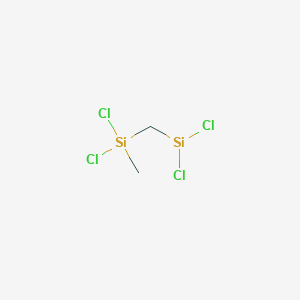
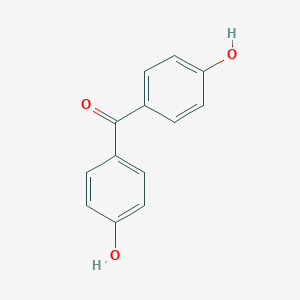
![[4-(2-oxo-2-phenylmethoxyethyl)phenyl] 4-(diaminomethylideneamino)benzoate;hydrochloride](/img/structure/B132228.png)
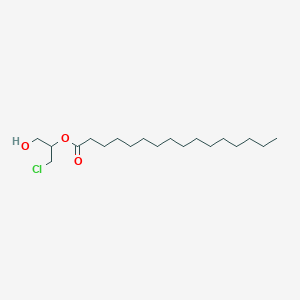

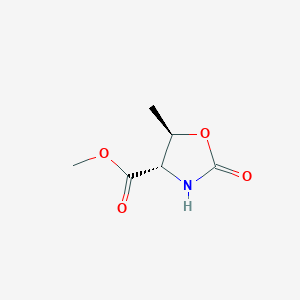
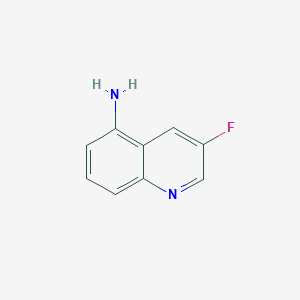
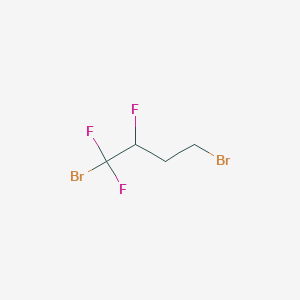
![2,2-Bis[4-(4-aminophenoxy)phenyl]propane](/img/structure/B132241.png)
![(3AS,3bS,6aS)-3,3a,3b,4,5,6,6a,7-octahydropentaleno[2,1-c]isoxazole](/img/structure/B132246.png)

![2-chloro-4-iodo-5-[(2S)-1-methylpyrrolidin-2-yl]pyridine](/img/structure/B132251.png)
![ETHANONE, 1-[(1S,5R)-3-AMINO-6,6-DIMETHYLBICYCLO[3.1.0]HEX-2-EN-2-YL]-](/img/structure/B132254.png)
![[(4R)-1-Hydroxy-4-(prop-1-en-2-yl)cyclohex-2-en-1-yl]methyl acetate](/img/structure/B132256.png)
